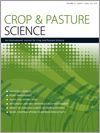CP20033Effects, tolerance mechanisms and management of salt stress in lucerne (Medicago sativa)

Growth, development and dry matter production of lucerne are affected by salt stress, which decreases seed germination, carbon fixation, light harvesting, biological N2 fixation, mineral uptake and assimilation and dry-matter accumulation. A comprehensive strategy involving existing genetic resources, exploiting new sources to create new variation, and a breeding approach involving many traits instead of just one is needed. Recent advances in the fields of biotechnology and genomics involving the identification of salt-conferring genes and quantitate trait loci will help to improve salt tolerance in lucerne.




